Criminology Project: Intelligence & Antisocial Behavior in Adolescents
VerifiedAdded on 2022/12/30
|18
|2478
|348
Project
AI Summary
This criminology project investigates the correlation between intelligence levels, psychopathic traits, and antisocial behaviors exhibited by adolescents. The research employed a quantitative methodology, collecting primary data through questionnaires administered to a sample of 30 participants aged 10, recruited via social media platforms. The study aimed to determine if adolescents with psychopathic traits demonstrate higher intelligence compared to those without such traits. The findings, analyzed using statistical methods, revealed a lack of significant association between learning from experience, judging others and antisocial behavior, thus not supporting the initial hypothesis. The project discusses the limitations encountered, including resource constraints and challenges in data collection, and highlights the need for more specific research on the interplay between intelligence, psychopathic traits, and adolescent behavior. The results suggest that there is no direct correlation between the ability to learn from experience and judging others with antisocial behavior.

Any topic related to criminology
1
1
Paraphrase This Document
Need a fresh take? Get an instant paraphrase of this document with our AI Paraphraser

Table of Contents
Title..................................................................................................................................................3
ABSTRACT....................................................................................................................................3
INTRODUCTION...........................................................................................................................3
METHODS......................................................................................................................................4
RESULTS........................................................................................................................................6
Discussion......................................................................................................................................14
REFERENCES..............................................................................................................................16
APPENDIX....................................................................................................................................17
2
Title..................................................................................................................................................3
ABSTRACT....................................................................................................................................3
INTRODUCTION...........................................................................................................................3
METHODS......................................................................................................................................4
RESULTS........................................................................................................................................6
Discussion......................................................................................................................................14
REFERENCES..............................................................................................................................16
APPENDIX....................................................................................................................................17
2
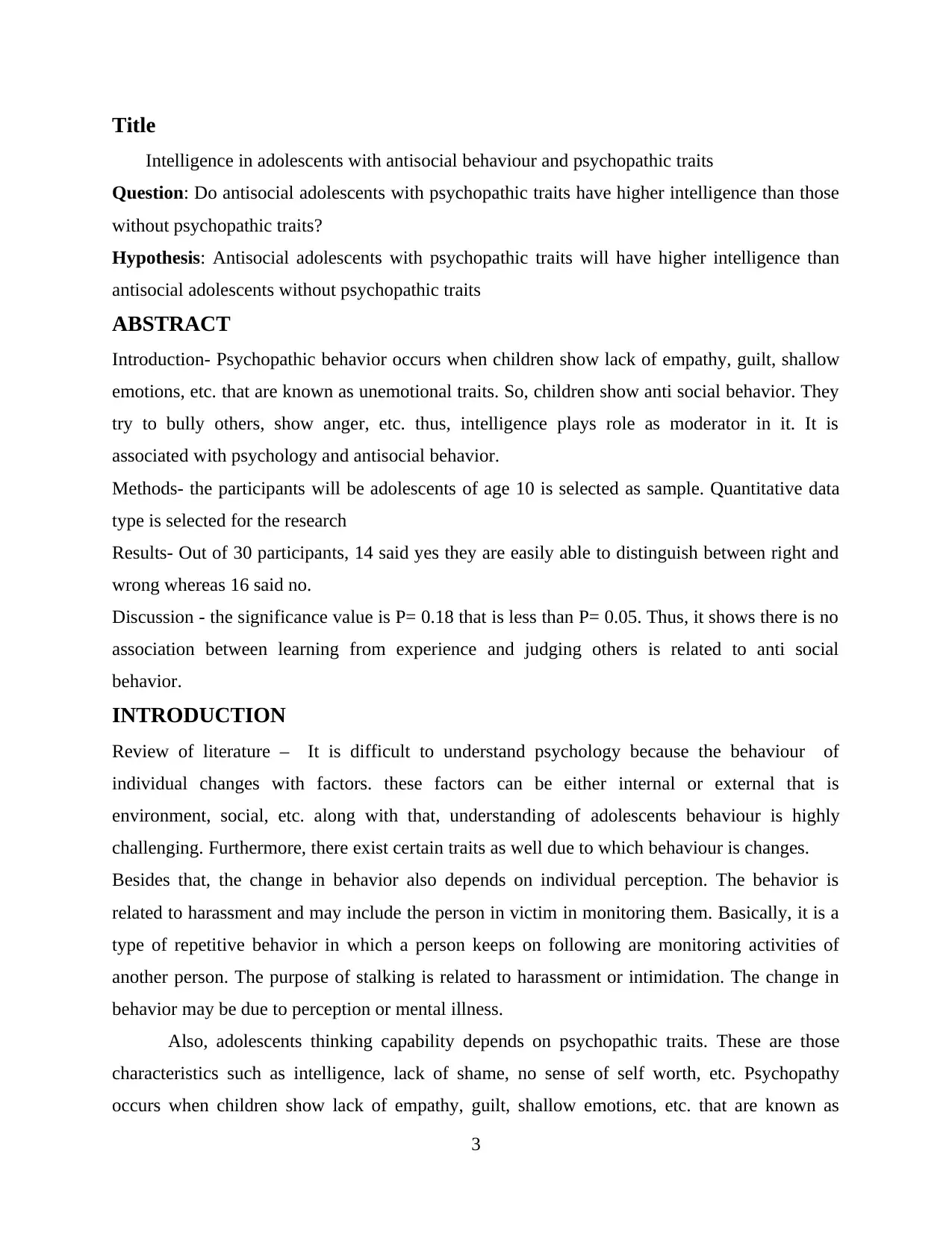
Title
Intelligence in adolescents with antisocial behaviour and psychopathic traits
Question: Do antisocial adolescents with psychopathic traits have higher intelligence than those
without psychopathic traits?
Hypothesis: Antisocial adolescents with psychopathic traits will have higher intelligence than
antisocial adolescents without psychopathic traits
ABSTRACT
Introduction- Psychopathic behavior occurs when children show lack of empathy, guilt, shallow
emotions, etc. that are known as unemotional traits. So, children show anti social behavior. They
try to bully others, show anger, etc. thus, intelligence plays role as moderator in it. It is
associated with psychology and antisocial behavior.
Methods- the participants will be adolescents of age 10 is selected as sample. Quantitative data
type is selected for the research
Results- Out of 30 participants, 14 said yes they are easily able to distinguish between right and
wrong whereas 16 said no.
Discussion - the significance value is P= 0.18 that is less than P= 0.05. Thus, it shows there is no
association between learning from experience and judging others is related to anti social
behavior.
INTRODUCTION
Review of literature – It is difficult to understand psychology because the behaviour of
individual changes with factors. these factors can be either internal or external that is
environment, social, etc. along with that, understanding of adolescents behaviour is highly
challenging. Furthermore, there exist certain traits as well due to which behaviour is changes.
Besides that, the change in behavior also depends on individual perception. The behavior is
related to harassment and may include the person in victim in monitoring them. Basically, it is a
type of repetitive behavior in which a person keeps on following are monitoring activities of
another person. The purpose of stalking is related to harassment or intimidation. The change in
behavior may be due to perception or mental illness.
Also, adolescents thinking capability depends on psychopathic traits. These are those
characteristics such as intelligence, lack of shame, no sense of self worth, etc. Psychopathy
occurs when children show lack of empathy, guilt, shallow emotions, etc. that are known as
3
Intelligence in adolescents with antisocial behaviour and psychopathic traits
Question: Do antisocial adolescents with psychopathic traits have higher intelligence than those
without psychopathic traits?
Hypothesis: Antisocial adolescents with psychopathic traits will have higher intelligence than
antisocial adolescents without psychopathic traits
ABSTRACT
Introduction- Psychopathic behavior occurs when children show lack of empathy, guilt, shallow
emotions, etc. that are known as unemotional traits. So, children show anti social behavior. They
try to bully others, show anger, etc. thus, intelligence plays role as moderator in it. It is
associated with psychology and antisocial behavior.
Methods- the participants will be adolescents of age 10 is selected as sample. Quantitative data
type is selected for the research
Results- Out of 30 participants, 14 said yes they are easily able to distinguish between right and
wrong whereas 16 said no.
Discussion - the significance value is P= 0.18 that is less than P= 0.05. Thus, it shows there is no
association between learning from experience and judging others is related to anti social
behavior.
INTRODUCTION
Review of literature – It is difficult to understand psychology because the behaviour of
individual changes with factors. these factors can be either internal or external that is
environment, social, etc. along with that, understanding of adolescents behaviour is highly
challenging. Furthermore, there exist certain traits as well due to which behaviour is changes.
Besides that, the change in behavior also depends on individual perception. The behavior is
related to harassment and may include the person in victim in monitoring them. Basically, it is a
type of repetitive behavior in which a person keeps on following are monitoring activities of
another person. The purpose of stalking is related to harassment or intimidation. The change in
behavior may be due to perception or mental illness.
Also, adolescents thinking capability depends on psychopathic traits. These are those
characteristics such as intelligence, lack of shame, no sense of self worth, etc. Psychopathy
occurs when children show lack of empathy, guilt, shallow emotions, etc. that are known as
3
⊘ This is a preview!⊘
Do you want full access?
Subscribe today to unlock all pages.

Trusted by 1+ million students worldwide

unemotional traits. So, these all increase psychopathic behavior. Hence, children show anti social
behavior. They try to bully others, show anger, etc. thus, intelligence plays role as moderator in
it. It is associated with psychology and antisocial behavior.
When there is increase in knowledge it results in improving behavior of adolescents.
They get engaged in learning and acquiring knowledge. In addition, there are ways related to
how traits result in psychopathic behavior.
This topic is selected because it will help in finding association between antisocial
adolescents have higher intelligence than those without psychopathic traits. Moreover, it can be
easily analysed role of psychopathic traits in adolescents and how their intelligence is affected.
Why topic is important
It has been evaluated that there exists gap as psychiatrists are not able to find out that
adolescents who are possess psychopathic traits have higher intelligence than those who not.
Furthermore, what traits are included in it. so, there is no difference that is being made in it. due
to that antisocial behaviour is not understood. The topic will help in determining traits of
adolescents and their intelligence. Besides that, it will help in relating relation with antisocial
behaviour and how psychopathic traits availability reflect on it.
Specific purpose of study
Thus, the main purpose of study is to find out that whether antisocial adolescents with
psychopathic traits will have higher intelligence than antisocial adolescents without psychopathic
traits. Thus, the relationship between antisocial behavior and psychopathic traits will be analysed
in it.
METHODS
Participants- the participants will be adolescents of age 10 and they will be hired with help of
random sampling method. Also, the data gathered will be primary data and for that questionnaire
will be used. It has been evaluated that data collection was really and cost effective as primary
data is being selected for the present study. It was also being Relevant and reliable data was
being collected by making use of primary data. It has also been analysed that primary data is
basically unpublished data and it is being used for specific purpose. This has assisted researcher
in getting end results and it has also assisted them in achieving goals and objectives which has
been set up by them (Krstic and et.al., 2018). It has also been evaluated that number of
participants which was taken for present study is 30. They have been recruited with the help of
4
behavior. They try to bully others, show anger, etc. thus, intelligence plays role as moderator in
it. It is associated with psychology and antisocial behavior.
When there is increase in knowledge it results in improving behavior of adolescents.
They get engaged in learning and acquiring knowledge. In addition, there are ways related to
how traits result in psychopathic behavior.
This topic is selected because it will help in finding association between antisocial
adolescents have higher intelligence than those without psychopathic traits. Moreover, it can be
easily analysed role of psychopathic traits in adolescents and how their intelligence is affected.
Why topic is important
It has been evaluated that there exists gap as psychiatrists are not able to find out that
adolescents who are possess psychopathic traits have higher intelligence than those who not.
Furthermore, what traits are included in it. so, there is no difference that is being made in it. due
to that antisocial behaviour is not understood. The topic will help in determining traits of
adolescents and their intelligence. Besides that, it will help in relating relation with antisocial
behaviour and how psychopathic traits availability reflect on it.
Specific purpose of study
Thus, the main purpose of study is to find out that whether antisocial adolescents with
psychopathic traits will have higher intelligence than antisocial adolescents without psychopathic
traits. Thus, the relationship between antisocial behavior and psychopathic traits will be analysed
in it.
METHODS
Participants- the participants will be adolescents of age 10 and they will be hired with help of
random sampling method. Also, the data gathered will be primary data and for that questionnaire
will be used. It has been evaluated that data collection was really and cost effective as primary
data is being selected for the present study. It was also being Relevant and reliable data was
being collected by making use of primary data. It has also been analysed that primary data is
basically unpublished data and it is being used for specific purpose. This has assisted researcher
in getting end results and it has also assisted them in achieving goals and objectives which has
been set up by them (Krstic and et.al., 2018). It has also been evaluated that number of
participants which was taken for present study is 30. They have been recruited with the help of
4
Paraphrase This Document
Need a fresh take? Get an instant paraphrase of this document with our AI Paraphraser

social media platform. It was easy to connect with them through online channels. It was also
being evaluated that in order to collect data, ethical code of conduct was being followed. This
has assisted researcher in achieving end goals and objectives. It has also been evaluated that
before conducting research consent was taken from the participants. Researchers also made sure
that data of participants remained confidential and it was not being leaked by them. This has
assisted researchers in making research better and also it is being evaluated that respect and
dignity is being followed for every participant throughout research. It was really necessary to do
so.
Measures/Materials: There are various materials which are been used for collecting the data. It
has been analysed that researchers have made use of computer and tablets to gather and analyse
data. They have connected with participants with the help of online channels. This has become
easier for researchers to connect with participants virtually. Materials which were used in order
to collect data included questionnaire. In this specific demographic questionnaire was been used.
This has assisted researcher in reaching out end results. It has also been evaluated that
throughout the research, researcher has made sure that no harm is been faced by participants
when research was being conducted (Eisenbarth, Hart and Sedikides, 2018). Researchers has
tried to provide high quality of data so that better end results can be provided to them. They have
also made use of better internet connectivity in order to connect with participants better. Due to
novel corona virus crisis, online
Method: Various type of research methods were being used. It has been analysed that researcher
has made use of deductive approach to gain end results as study was quantitative in nature. It has
been analysed that experimental design is being used in research. It was being done so that data
can be better analysed and also high quality of information can be gathered by making use of
these research methods. Quantitative data type is selected for the research. In this statically
analysis is being done so that better result can be find out. This has assisted in better extraction
of data and also because of this researcher have been able to collect better and adequate
information. In this research the participants were been selected by researcher randomly. This
has assisted them in making sure that no biasness exists and also it assisted in achieving
objective.
5
being evaluated that in order to collect data, ethical code of conduct was being followed. This
has assisted researcher in achieving end goals and objectives. It has also been evaluated that
before conducting research consent was taken from the participants. Researchers also made sure
that data of participants remained confidential and it was not being leaked by them. This has
assisted researchers in making research better and also it is being evaluated that respect and
dignity is being followed for every participant throughout research. It was really necessary to do
so.
Measures/Materials: There are various materials which are been used for collecting the data. It
has been analysed that researchers have made use of computer and tablets to gather and analyse
data. They have connected with participants with the help of online channels. This has become
easier for researchers to connect with participants virtually. Materials which were used in order
to collect data included questionnaire. In this specific demographic questionnaire was been used.
This has assisted researcher in reaching out end results. It has also been evaluated that
throughout the research, researcher has made sure that no harm is been faced by participants
when research was being conducted (Eisenbarth, Hart and Sedikides, 2018). Researchers has
tried to provide high quality of data so that better end results can be provided to them. They have
also made use of better internet connectivity in order to connect with participants better. Due to
novel corona virus crisis, online
Method: Various type of research methods were being used. It has been analysed that researcher
has made use of deductive approach to gain end results as study was quantitative in nature. It has
been analysed that experimental design is being used in research. It was being done so that data
can be better analysed and also high quality of information can be gathered by making use of
these research methods. Quantitative data type is selected for the research. In this statically
analysis is being done so that better result can be find out. This has assisted in better extraction
of data and also because of this researcher have been able to collect better and adequate
information. In this research the participants were been selected by researcher randomly. This
has assisted them in making sure that no biasness exists and also it assisted in achieving
objective.
5
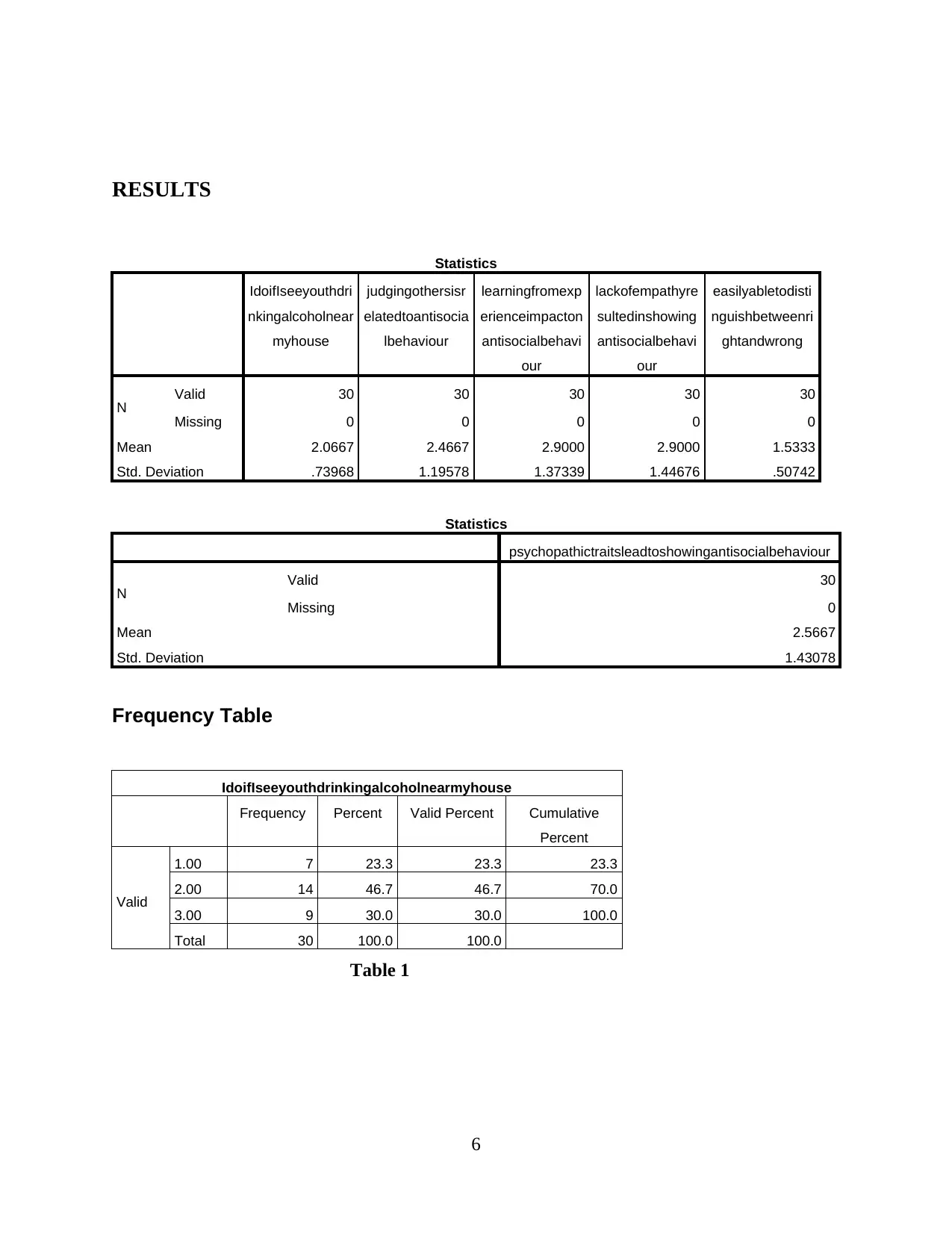
RESULTS
Statistics
IdoifIseeyouthdri
nkingalcoholnear
myhouse
judgingothersisr
elatedtoantisocia
lbehaviour
learningfromexp
erienceimpacton
antisocialbehavi
our
lackofempathyre
sultedinshowing
antisocialbehavi
our
easilyabletodisti
nguishbetweenri
ghtandwrong
N Valid 30 30 30 30 30
Missing 0 0 0 0 0
Mean 2.0667 2.4667 2.9000 2.9000 1.5333
Std. Deviation .73968 1.19578 1.37339 1.44676 .50742
Statistics
psychopathictraitsleadtoshowingantisocialbehaviour
N Valid 30
Missing 0
Mean 2.5667
Std. Deviation 1.43078
Frequency Table
IdoifIseeyouthdrinkingalcoholnearmyhouse
Frequency Percent Valid Percent Cumulative
Percent
Valid
1.00 7 23.3 23.3 23.3
2.00 14 46.7 46.7 70.0
3.00 9 30.0 30.0 100.0
Total 30 100.0 100.0
Table 1
6
Statistics
IdoifIseeyouthdri
nkingalcoholnear
myhouse
judgingothersisr
elatedtoantisocia
lbehaviour
learningfromexp
erienceimpacton
antisocialbehavi
our
lackofempathyre
sultedinshowing
antisocialbehavi
our
easilyabletodisti
nguishbetweenri
ghtandwrong
N Valid 30 30 30 30 30
Missing 0 0 0 0 0
Mean 2.0667 2.4667 2.9000 2.9000 1.5333
Std. Deviation .73968 1.19578 1.37339 1.44676 .50742
Statistics
psychopathictraitsleadtoshowingantisocialbehaviour
N Valid 30
Missing 0
Mean 2.5667
Std. Deviation 1.43078
Frequency Table
IdoifIseeyouthdrinkingalcoholnearmyhouse
Frequency Percent Valid Percent Cumulative
Percent
Valid
1.00 7 23.3 23.3 23.3
2.00 14 46.7 46.7 70.0
3.00 9 30.0 30.0 100.0
Total 30 100.0 100.0
Table 1
6
⊘ This is a preview!⊘
Do you want full access?
Subscribe today to unlock all pages.

Trusted by 1+ million students worldwide
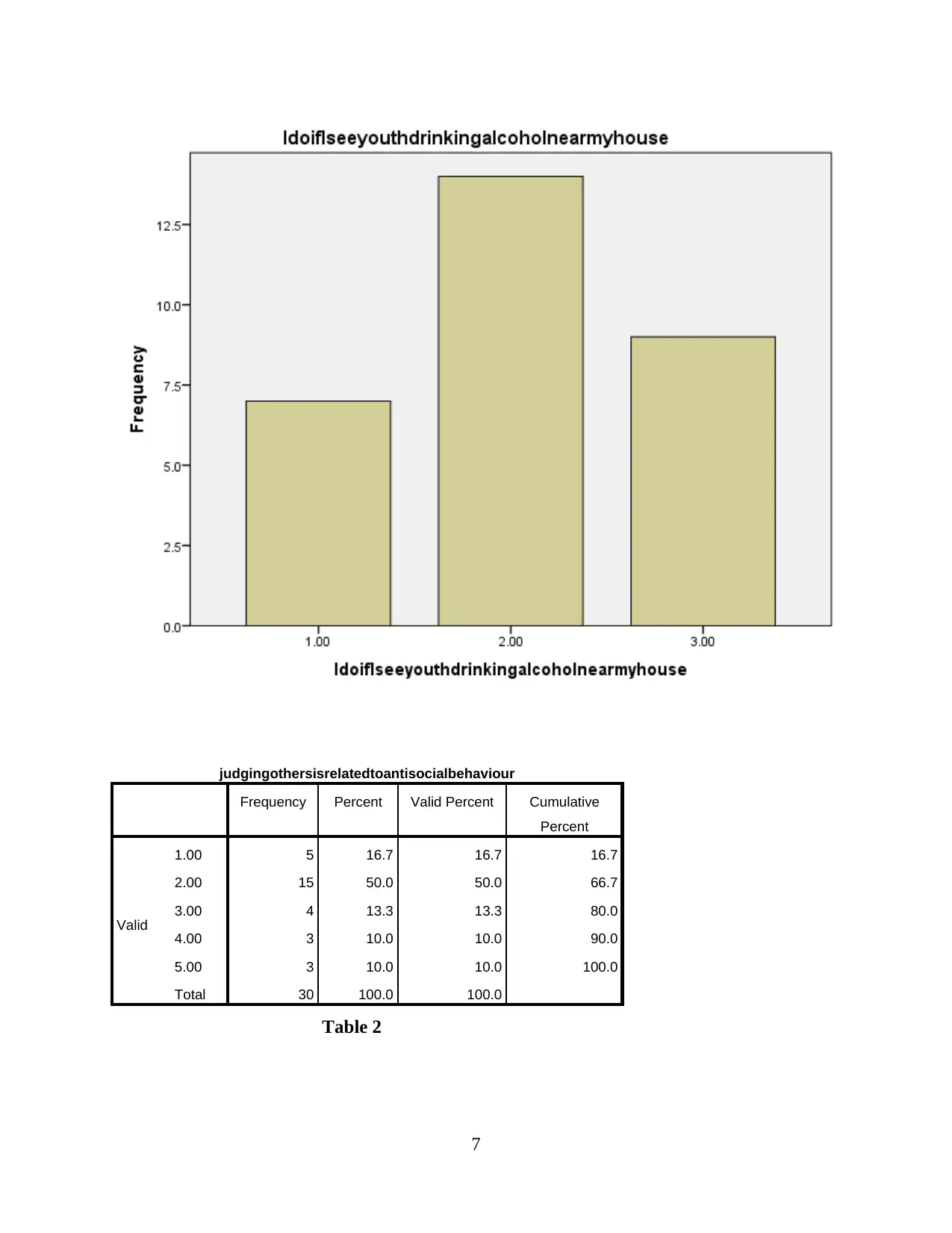
judgingothersisrelatedtoantisocialbehaviour
Frequency Percent Valid Percent Cumulative
Percent
Valid
1.00 5 16.7 16.7 16.7
2.00 15 50.0 50.0 66.7
3.00 4 13.3 13.3 80.0
4.00 3 10.0 10.0 90.0
5.00 3 10.0 10.0 100.0
Total 30 100.0 100.0
Table 2
7
Frequency Percent Valid Percent Cumulative
Percent
Valid
1.00 5 16.7 16.7 16.7
2.00 15 50.0 50.0 66.7
3.00 4 13.3 13.3 80.0
4.00 3 10.0 10.0 90.0
5.00 3 10.0 10.0 100.0
Total 30 100.0 100.0
Table 2
7
Paraphrase This Document
Need a fresh take? Get an instant paraphrase of this document with our AI Paraphraser

learningfromexperienceimpactonantisocialbehaviour
Frequency Percent Valid Percent Cumulative
Percent
Valid
1.00 4 13.3 13.3 13.3
2.00 11 36.7 36.7 50.0
3.00 5 16.7 16.7 66.7
4.00 4 13.3 13.3 80.0
5.00 6 20.0 20.0 100.0
Total 30 100.0 100.0
Table 3
8
Frequency Percent Valid Percent Cumulative
Percent
Valid
1.00 4 13.3 13.3 13.3
2.00 11 36.7 36.7 50.0
3.00 5 16.7 16.7 66.7
4.00 4 13.3 13.3 80.0
5.00 6 20.0 20.0 100.0
Total 30 100.0 100.0
Table 3
8
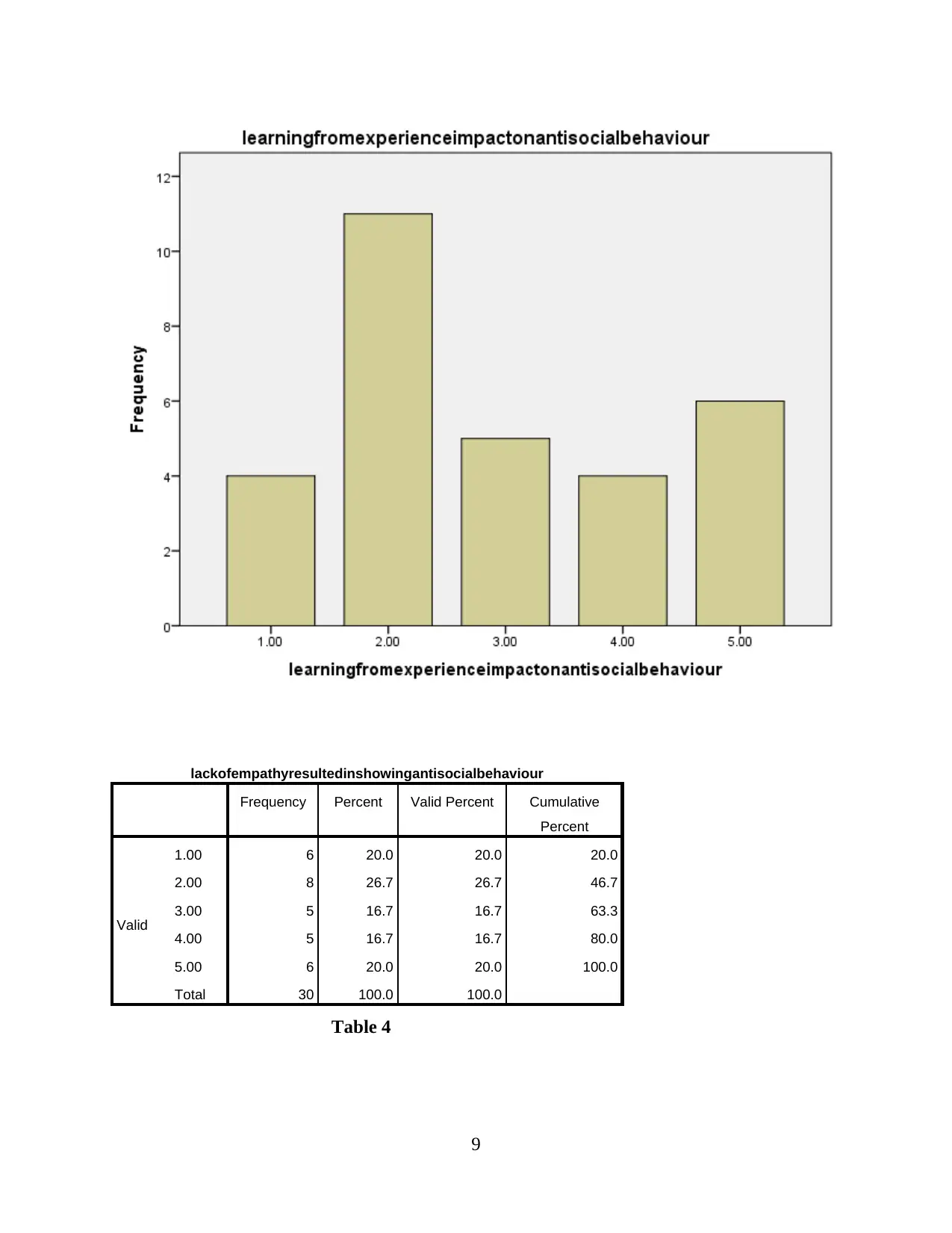
lackofempathyresultedinshowingantisocialbehaviour
Frequency Percent Valid Percent Cumulative
Percent
Valid
1.00 6 20.0 20.0 20.0
2.00 8 26.7 26.7 46.7
3.00 5 16.7 16.7 63.3
4.00 5 16.7 16.7 80.0
5.00 6 20.0 20.0 100.0
Total 30 100.0 100.0
Table 4
9
Frequency Percent Valid Percent Cumulative
Percent
Valid
1.00 6 20.0 20.0 20.0
2.00 8 26.7 26.7 46.7
3.00 5 16.7 16.7 63.3
4.00 5 16.7 16.7 80.0
5.00 6 20.0 20.0 100.0
Total 30 100.0 100.0
Table 4
9
⊘ This is a preview!⊘
Do you want full access?
Subscribe today to unlock all pages.

Trusted by 1+ million students worldwide
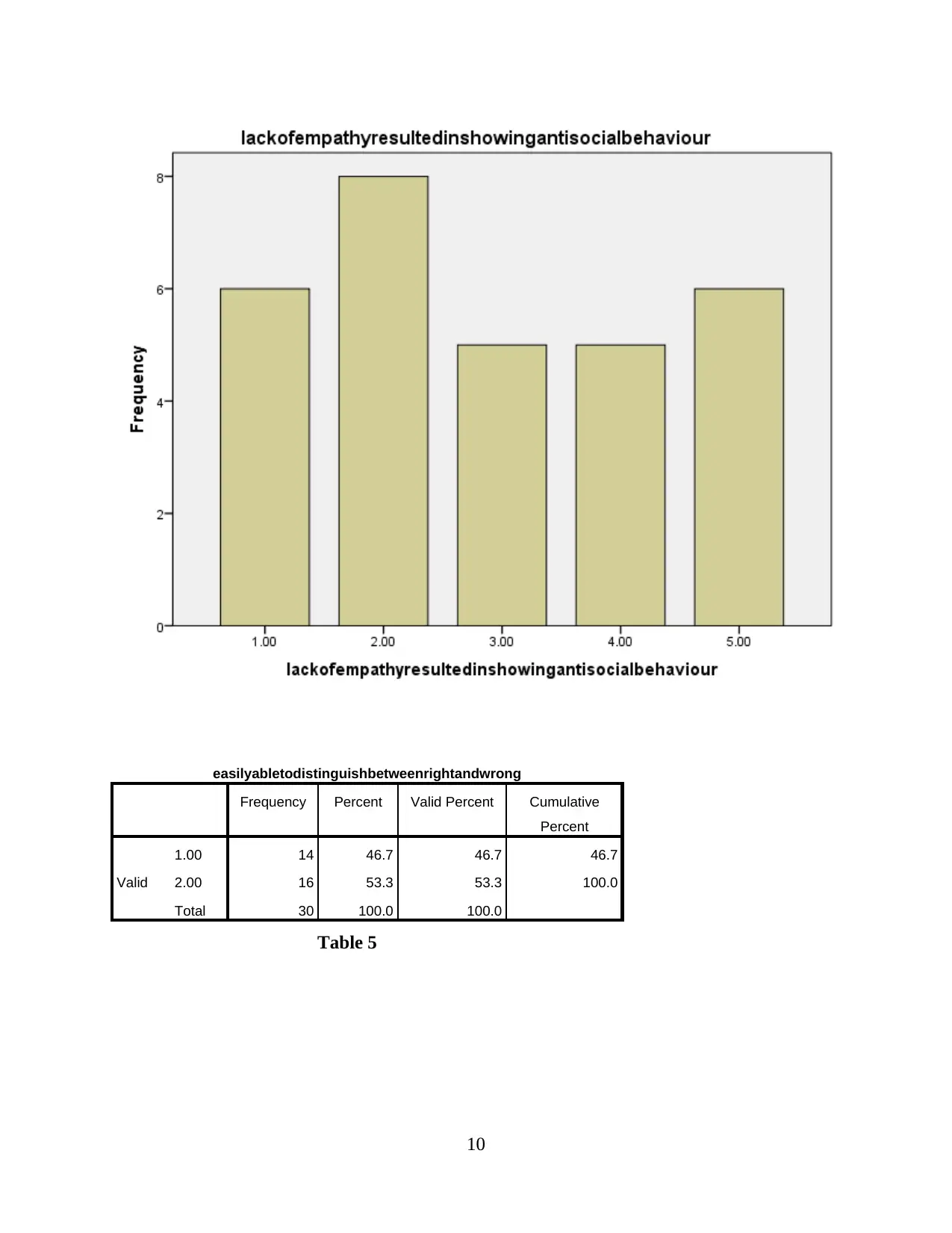
easilyabletodistinguishbetweenrightandwrong
Frequency Percent Valid Percent Cumulative
Percent
Valid
1.00 14 46.7 46.7 46.7
2.00 16 53.3 53.3 100.0
Total 30 100.0 100.0
Table 5
10
Frequency Percent Valid Percent Cumulative
Percent
Valid
1.00 14 46.7 46.7 46.7
2.00 16 53.3 53.3 100.0
Total 30 100.0 100.0
Table 5
10
Paraphrase This Document
Need a fresh take? Get an instant paraphrase of this document with our AI Paraphraser
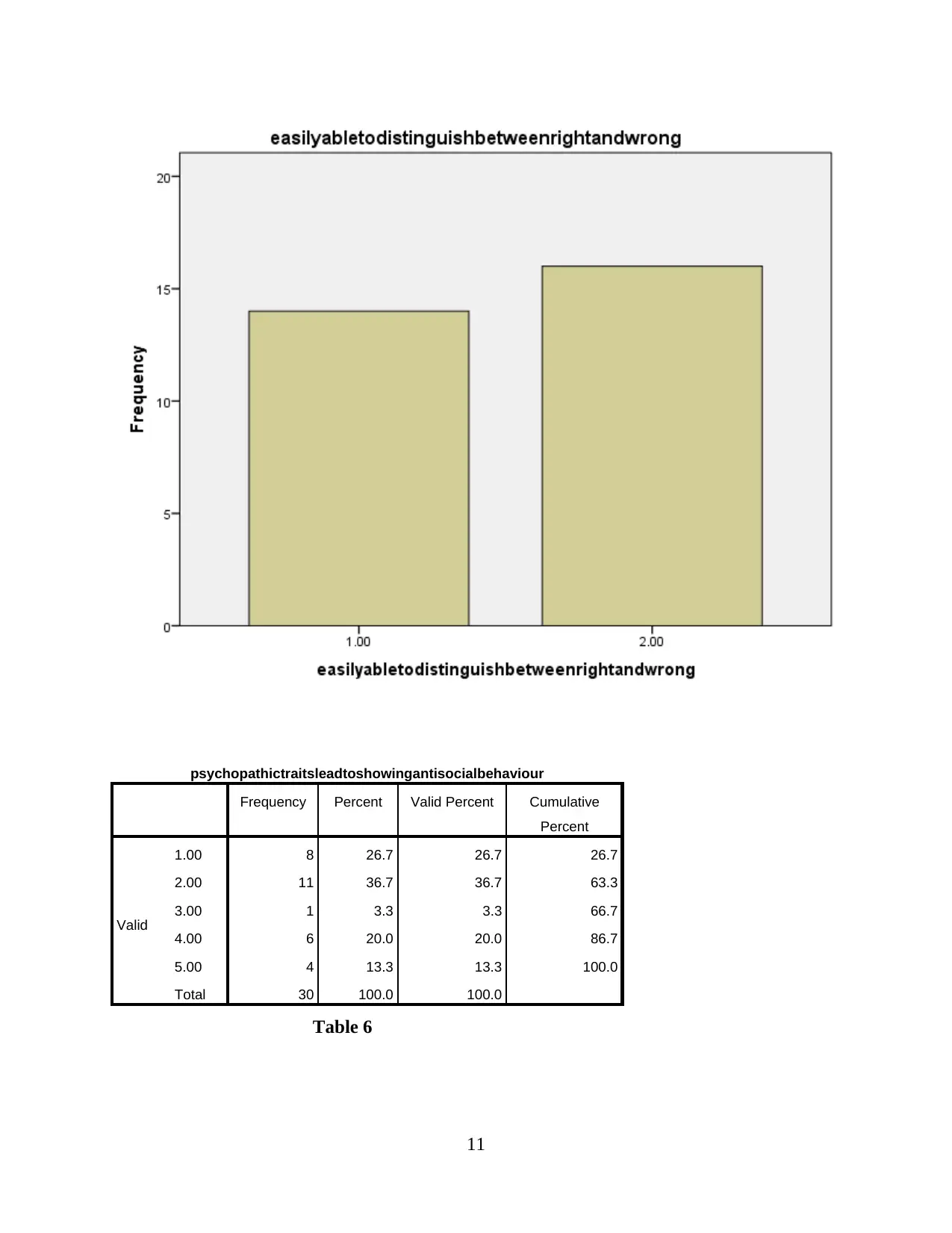
psychopathictraitsleadtoshowingantisocialbehaviour
Frequency Percent Valid Percent Cumulative
Percent
Valid
1.00 8 26.7 26.7 26.7
2.00 11 36.7 36.7 63.3
3.00 1 3.3 3.3 66.7
4.00 6 20.0 20.0 86.7
5.00 4 13.3 13.3 100.0
Total 30 100.0 100.0
Table 6
11
Frequency Percent Valid Percent Cumulative
Percent
Valid
1.00 8 26.7 26.7 26.7
2.00 11 36.7 36.7 63.3
3.00 1 3.3 3.3 66.7
4.00 6 20.0 20.0 86.7
5.00 4 13.3 13.3 100.0
Total 30 100.0 100.0
Table 6
11

Correlation
Correlations
lackofempathyre
sultedinshowing
antisocialbehavi
our
psychopathictrait
sleadtoshowinga
ntisocialbehavio
ur
lackofempathyresultedinsho
wingantisocialbehaviour
Pearson Correlation 1 .012
Sig. (2-tailed) .951
N 30 30
Pearson Correlation .012 1
12
Correlations
lackofempathyre
sultedinshowing
antisocialbehavi
our
psychopathictrait
sleadtoshowinga
ntisocialbehavio
ur
lackofempathyresultedinsho
wingantisocialbehaviour
Pearson Correlation 1 .012
Sig. (2-tailed) .951
N 30 30
Pearson Correlation .012 1
12
⊘ This is a preview!⊘
Do you want full access?
Subscribe today to unlock all pages.

Trusted by 1+ million students worldwide
1 out of 18
Your All-in-One AI-Powered Toolkit for Academic Success.
+13062052269
info@desklib.com
Available 24*7 on WhatsApp / Email
![[object Object]](/_next/static/media/star-bottom.7253800d.svg)
Unlock your academic potential
Copyright © 2020–2025 A2Z Services. All Rights Reserved. Developed and managed by ZUCOL.

